Ordering in WPF PropertyGrid
7 May 202113 minutes to read
We can order the properties according to our needs. We can change the order of the properties by attributes and event.
Ordering using Attribute
The properties in PropertyGrid will be ordered based on the value specified in the Order field of Display attribute. If we need to change the order of the properties, we should set the SortDirection property to null.
public class Employee {
[Display(Order = 4)]
public String Gender { get; set; }
[Display(Order = 7)]
[Category("Address")]
public String Country { get; set; }
[Display(Order = 6)]
[Category("Contact Details")]
public string Email { get; set; }
[Display(Order = 0)]
[Category("Identity")]
public string FirstName { get; set; }
public string Designation { get; set; }
[Display(Order = 1)]
[Category("Identity")]
public string LastName { get; set; }
public string ID { get; set; }
[Display(Order = 4)]
public DateTime DOB { get; set; }
[Display(Order = 5)]
[Category("Contact Details")]
public string Mobile { get; set; }
[Display(Order = 2)]
public int Age { get; set; }
}
public class ViewModel {
public Object SelectedEmplyee { get; set; }
public ViewModel() {
SelectedEmplyee = new Employee() {
FirstName = "Carl",
LastName = "johnson",
Age = 30,
Country = "United States",
Designation = "Team Lead",
DOB = new DateTime(2000, 12, 01),
Email = "[email protected]",
Gender = "Male",
ID = "SF001",
Mobile = "1234567890"
};
}
}<syncfusion:PropertyGrid SelectedObject="{Binding SelectedEmployee}" EnableGrouping="True"
SortDirection="{x:Null}" x:Name="propertyGrid1" >
<syncfusion:PropertyGrid.DataContext>
<local:ViewModel></local:ViewModel>
</syncfusion:PropertyGrid.DataContext>
</syncfusion:PropertyGrid>PropertyGrid propertyGrid1 = new PropertyGrid();
propertyGrid1.DataContext = new ViewModel();
propertyGrid1.SetBinding(PropertyGrid.SelectedObjectProperty, new Binding("SelectedEmployee"));
propertyGrid1.EnableGrouping = true;
propertyGrid1.SortDirection = null;Ordering in Group view
Based on the value specified in the Order field of Display attribute, the property items will be ordered and grouped. Groups are ordered according to group which contains the lower ordered property.
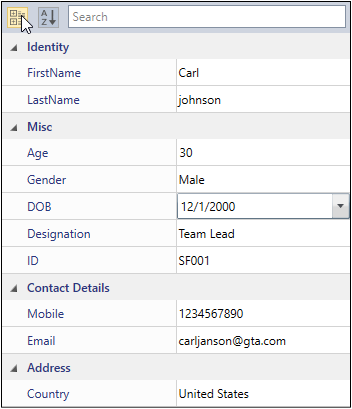
Here, the FirstName property contains the lower order as 0 and categorized under the Identity category. Then the Identity category ordered as first. After that, Age property contains the lower order as 2 from another category, So Misc category ordered as second and vice versa.
Ordering with Sort view
If more than one property has same Order value, then the properties with distinct numbers will be added first, then the duplicate order properties will be added. Also, if any of the properties doesn’t have order, that properties will be arranged at last based on the order in which they were added in the class.
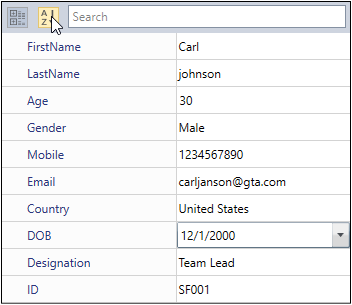
Here, the property DOB and Gender has same order but the Gender property is added prior than DOB. So the Gender property will be arranged in 4th place, and the DOB is arranged after Country property. And the other non-specified order properties are arranged based on the order in which they were added to the Class.
Ordering based on properties defined in class
The Ordering can be performed without using any Attributes. If the SortDirection property is null and the properties have no custom order, then the properties will be ordered according to the order in which they were added to the class.
using System;
using System.ComponentModel;
public class Employee {
[Category("Identity")]
public String Gender { get; set; }
[Category("Address")]
public String Country { get; set; }
[Category("Contact Details")]
public string Email { get; set; }
[Category("Identity")]
public string FirstName { get; set; }
public string Designation { get; set; }
[Category("Identity")]
public string LastName { get; set; }
public string ID { get; set; }
public DateTime DOB { get; set; }
[Category("Contact Details")]
public string Mobile { get; set; }
public int Age { get; set; }
}
public class ViewModel {
public Object SelectedEmployee { get; set; }
public ViewModel() {
SelectedEmployee = new Employee()
{
FirstName = "Carl",
LastName = "johnson",
Age = 30,
Country = "United States",
Designation = "Team Lead",
DOB = new DateTime(2000, 12, 01),
Email = "[email protected]",
Gender = "Male",
ID = "SF001",
Mobile = "1234567890"
};
}
}<syncfusion:PropertyGrid SelectedObject="{Binding SelectedEmployee}"
SortDirection="{x:Null}" x:Name="propertyGrid1" >
<syncfusion:PropertyGrid.DataContext>
<local:ViewModel></local:ViewModel>
</syncfusion:PropertyGrid.DataContext>
</syncfusion:PropertyGrid>PropertyGrid propertyGrid1 = new PropertyGrid();
propertyGrid1.DataContext = new ViewModel();
propertyGrid1.SetBinding(PropertyGrid.SelectedObjectProperty, new Binding("SelectedEmployee"));
propertyGrid1.SortDirection = null;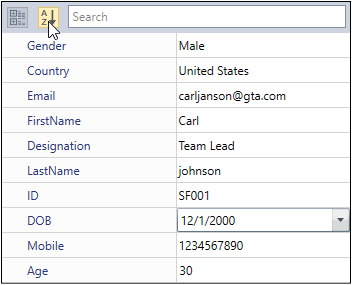
Here, the properties are arranged from the Gender property and end with Age property by the order in which they were added to the class.
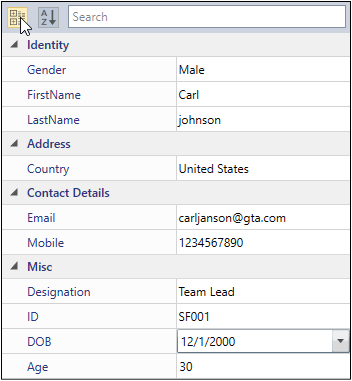
Here, the Gender property added in the class at first and categorized under the Identity category. Then the Identity category ordered as first. After that, Country property added in the class from another category, So Address category ordered as second and vice versa.
NOTE
If you use both
OrderingandSorting,Sortinghave higher priority. So the properties are arranged eitherAscendingorDescendingorder according to the sorting value.
Click here to download the sample that showcases the property ordering support using the attributes.
Change Property order at runtime
We can set the property order without using the attributes and can change the property order at runtime by handling the AutoGeneratingPropertyGridItem event with AutoGeneratingPropertyGridItemEventArgs.Order property.
using System;
using System.ComponentModel;
using System.ComponentModel.DataAnnotations;
public class Employee {
public string Name { get; set; }
public string ID { get; set; }
public DateTime DOB { get; set; }
public int Experience { get; set; }
}
public class ViewModel {
public object SelectedEmployee { get; set; }
public ViewModel() {
SelectedEmployee = new Employee()
{
Name = "John",
ID = "381",
DOB = new DateTime(1995, 12, 24),
Experience = 5;
};
}
}<syncfusion:PropertyGrid AutoGeneratingPropertyGridItem="PropertyGrid1_AutoGeneratingPropertyGridItem"
SortDirection="{x:Null}"
SelectedObject="{Binding SelectedEmployee}"
x:Name="propertyGrid1">
<syncfusion:PropertyGrid.DataContext>
<local:ViewModel></local:ViewModel>
</syncfusion:PropertyGrid.DataContext>
</syncfusion:PropertyGrid>PropertyGrid propertyGrid1 = new PropertyGrid();
propertyGrid1.DataContext = new ViewModel();
propertyGrid1.SetBinding(PropertyGrid.SelectedObjectProperty, new Binding("SelectedEmployee"));
propertyGrid1.SortDirection = null;
propertyGrid1.AutoGeneratingPropertyGridItem += PropertyGrid1_AutoGeneratingPropertyGridItem;private void PropertyGrid1_AutoGeneratingPropertyGridItem(object sender, AutoGeneratingPropertyGridItemEventArgs e) {
//Experience, DOB, Name and ID properties ordered by the Order property.
if (e.DisplayName == "Experience") {
e.Order = 3;
}
else if (e.DisplayName == "DOB") {
e.Order = 2;
}
else if (e.DisplayName == "Name") {
e.Order = 0;
}
else if (e.DisplayName == "ID") {
e.Order = 1;
}
}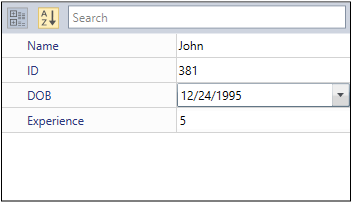
Here, the Name property is arranged at first and Experience property arranged at fourth position based on the value specified in the AutoGeneratingPropertyGridItemArgs.Order property.
Click here to download the sample that showcases the property Description support using AutoGeneratingPropertyGridItem event.